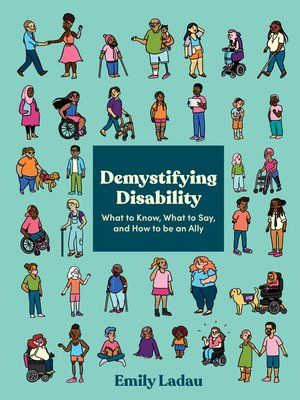NYC School Librarian Guidebook: Accessibility
Introduction to Accessibility
Libraries should be proactive in creating accessible facilities to visitors with a wide range of abilities and disabilities. At a minimum, all US libraries are required to comply with the Americans with Disabilities Act (ADA), which requires that structural barriers in libraries be removed or remediated to allow people with disabilities to access spaces. Accessibility also means presenting information and designing resources that are accessible to people with different abilities, including the use of assistive technology.
At New York City Public Schools, we are committed to providing accessible information and resources for everyone. The American Library Association’s Library Services for People with Disabilities Policy declares that “Libraries should use strategies based upon the principles of universal design to ensure that library policy, resources and services meet the needs of all people.” Universal Design for libraries goes beyond meeting the baseline guidelines for accessibility as required by the ADA.
The resources on this page will provide guidance and examples of how to make your library more accessible.
Quick Tips:
- Have content available in a variety of formats, including ebooks, audiobooks, graphic novels, large print, novels in verse, and picture books.
- Have flexible furniture and multiple options for seating, ideally modular and adjustable furniture.
- Leave plenty of spacing in the aisles, between tables, and at entry and exit points.
- Use clear, consistent signage throughout that has visuals, such as images or symbols.
- Use color-coded labeling for easy access.
- Be mindful of shelf height for books. Don't use the top shelf if it is out of reach for most patrons.
Accessibility Titles in Sora

Developing a Library Accessibility Plan: A Practical Guide for Librarians by Rebecca M. Marrall
As the title promises, Developing a Library Accessibility Plan is a practical guide for librarians that offers the knowledge, tools and templates, and practical examples necessary for developing a tailored and comprehensive accessibility plan for electronic, physical, and instructional and/or programming-related accessibility issues within their library.

Demystifying Disability: What to Know, What to Say, and How to Be an Ally by Emily Ladau
An approachable guide to being a thoughtful, informed ally to disabled people, with actionable steps for what to say and do (and what not to do) and how you can make the world a more inclusive place. Authored by celebrated disability rights advocate, speaker, and writer Emily Ladau, this practical, intersectional guide offers all readers a welcoming place to understand disability as part of the human experience.

Making Library Websites Accessible: A Practical Guide for Librarians by Laura Francabandera
A guide to online accessibility for library websites, Making Library Websites Accessible provides practical information on web accessibility specific to the processes and concerns of libraries. It includes the basics of web accessibility standards, laws and regulations, real-life scenarios, guidelines for negotiations with library vendors, as well as accessibility testing forms, templates, and checklists.

Best Practices in Designing Courses with Open Educational Resources by Olena Zhadko and Susan Ko
A practical guide that assists faculty and institutions looking to adopt and implement open educational resources (OER) and to foster meaningful, effective learning experiences through the course design process, Best Practices in Designing Courses with Open Educational Resources is loaded with tips, case examples, and guidance from practitioners to advise readers through each step necessary for sustainable OER initiatives from preliminary planning and course redesign through teaching, learning, and faculty development.
Accessibility Resource Links
-
Equal Access: Universal Design of LibrariesA checklist for making libraries welcoming, accessible, and usable for all patrons.
-
Universal Design Checklist for LibrariesA checklist to evaluate the extent a library adheres to seven UD principles.
-
Accessibility Checklist for LibGuides and Microsoft Office DocumentsA checklist from WeTeachNYC for creating accessible Microsoft Office files and LibGuides.
-
ADA Library Accessibility ChecklistA checklist specifically for libraries to evaluate compliance with the Americans with Disabilities Act (ADA). Provided by Project ENABLE from Syracuse University.
-
Full ADA Checkist for Existing FacilitiesThis tool includes the full list of ADA guidelines and standards for places of public accommodation.
-
Academic Library Building Design: Resources for Planning: Accessibility / Universal DesignA tool from ACRL and Core that provides a basic framework for architects, planners, and librarians embarking on the planning and design of libraries for higher education.
-
Addressing Reading DifficultiesA flowchart with practical tools and solutions for supporting students with reading difficulties.
Assistive Technology
The Assistive Technology Industry Association defines assistive technology or AT as "any item, piece of equipment, software program, or product system that is used to increase, maintain, or improve the functional capabilities of persons with disabilities." Assistive Technology can help students gain access to information and academic content to complete tasks and meet goals. AT can be low-tech, such as pencil grips and fidgets, or high-tech such as computer software and specialized devices.
-
Assistive Technology in NYC Public SchoolsLearn about the AT evaluation process.
-
Assistive Technology SupportsA list of commonly used AT devices and software and how to use them.
-
NY State Assistive Technology TRIAD ProgramA program that provides access to assistive technology to any New Yorker with a disability.
-
Family Guide to Assistive Technology (in English)A guide from NYC Public Schools to inform families about available AT and Accessible Education Materials (AEM) resources. Last updated in 2016.
-
Brochure from AT Help (2022)A useful one-pager with AT supports, resources, and tools.
